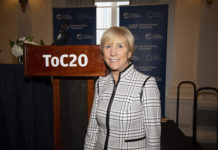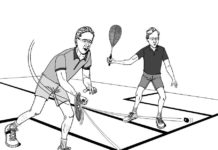By Kevin Klipstein
President Obama has recently come under fire for managing the White House like a boys club, with talk of sports around the water cooler and frequent basketball games with only men. He made headlines the other week by finally including a woman in his golf foursome, the 25th round that he’s played since becoming president. It’s hard to believe that there is really a gender bias in the White House, with women in such senior cabinet and advisory positions, and with President Obama going home every night to the most important people in his life, three females. But perceptions don’t always reflect reality.
Similarly, much has been written about the paucity of women squash players and the possible reasons for this trend, but this coverage does not necessarily tell the whole story. As recently as 2006, females made up only 14% of the membership, the percent is now 26%. We’ve seen a 77% increase in the number of girls achieving a final season ranking since 2004, and more girls than boys qualified as U.S. SQUASH Scholar-Athletes this season. When the U.S. High School Championships launched in 2004, there were no girls’ teams. Earlier this year, 44 of the 102 teams were girls’ teams. Our Junior Women’s Team placed 4th, a few points away from 2nd, at the World Championships this summer. On the adult side, the Howe Cup has seen participation consistently exceed 200 players the last five years, and a women’s doubles tour started two years ago and continues to grow, founded by recent Women’s Sports Foundation (WSF) honoree Narelle Krizek. Also honored by the WSF at their recent annual dinner was World No. 3 and US No. 1 Natalie Grainger. Two women, Diana Dowling and Icy Frantz, were recently elected to serve on the U.S. SQUASH Board of Directors.
Once again though, these positive signs don’t necessarily paint the complete picture. While we believe that a rising tide lifts all ships, meaning as we increase participation in the sport, naturally the number of women, and the proportion of women in squash, will increase, we also understand that there are significant challenges keeping women engaged in squash.
This is something we are taking seriously at U.S. SQUASH. We have three strategic priorities at U.S. SQUASH: grow membership, build awareness and increase participation with the goal of strengthening the finances of the Association. Of the five major initiatives we are focused on to accomplish these objectives, two are targeted directly at increasing women’s participation: our PLAY SQUASH program and our support for the College Squash Association (CSA).
“PLAY SQUASH” is an initiative to encourage in-club squash play and participation. The program offers pros and coordinators the online tools needed to easily organize play at the club level, and offers players engaging ways to enjoy squash no matter their skill level including in-club Challenge Ladders and Box Leagues. These options offer opportunities to play with less of a time commitment than tournaments and team leagues.
Through our partnership with the CSA, we are working to increase the number of women’s club and varsity squash programs across the country. Women’s squash has the opportunity to become recognized by the NCAA as more than an emerging sport if the number of varsity programs exceeds 40. There are currently 30 women’s varsity programs. We are also extending college player memberships until age 25 to maintain the connection between the sport and these players as the graduates adapt to post-college reality and with the goal of keeping squash an integral part of their daily lives.
In addition to these initiatives, the Women’s Committee, headed by former U.S. SQUASH Board Chair Jeannie Blasberg, continues to push hard on several initiatives, including driving tournament participation among women by encouraging strong draws at a “tour” of events throughout the season, while also encouraging Districts to host more casual, social play during evenings hosted by women, for women.
The story of women’s squash is more complex than a simple headline, though one that we’re aiming to see soon goes something like this, “GROWTH IN THE WOMEN’S GAME DRIVES U.S. SQUASH MEMBERSHIP TO NEW HIGHS.”





